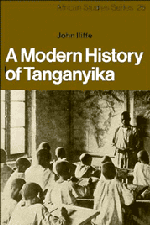Book contents
- Frontmatter
- Contents
- List of maps and tables
- Preface
- Acknowledgments
- Terminology
- Abbreviations
- Map I Tanganyika
- 1 Intentions
- 2 Tanganyika in 1800
- 3 The nineteenth century
- 4 The German conquest
- 5 Colonial economy and ecological crisis, 1890–1914
- 6 The Maji Maji rebellion, 1905–7
- 7 Religious and cultural change before 1914
- 8 Fortunes of war
- 9 The origins of rural capitalism
- 10 The creation of tribes
- 11 The crisis of colonial society, 1929–45
- 12 Townsmen and workers
- 13 The African Association, 1929–48
- 14 The new colonialism
- 15 The new politics, 1945–55
- 16 The nationalist victory, 1955–61
- Bibliography
- Index
7 - Religious and cultural change before 1914
Published online by Cambridge University Press: 03 May 2011
- Frontmatter
- Contents
- List of maps and tables
- Preface
- Acknowledgments
- Terminology
- Abbreviations
- Map I Tanganyika
- 1 Intentions
- 2 Tanganyika in 1800
- 3 The nineteenth century
- 4 The German conquest
- 5 Colonial economy and ecological crisis, 1890–1914
- 6 The Maji Maji rebellion, 1905–7
- 7 Religious and cultural change before 1914
- 8 Fortunes of war
- 9 The origins of rural capitalism
- 10 The creation of tribes
- 11 The crisis of colonial society, 1929–45
- 12 Townsmen and workers
- 13 The African Association, 1929–48
- 14 The new colonialism
- 15 The new politics, 1945–55
- 16 The nationalist victory, 1955–61
- Bibliography
- Index
Summary
As colonial rule became increasingly pervasive, so Tanganyika witnessed accelerated interaction among its indigenous religions, Islam, and Christianity. This interaction is best analysed by distinguishing between the function of religion as a means of countering evil and its function as an intellectual system charting and explaining the world. Indigeneous religions continued to offer remedies for ancient evils but were ill-equipped to explain or control the larger colonial world. Islam provided solutions at both levels but continued to experience contradiction between its world-view and its problem-solving techniques. Christianity was best able to explain the larger world, but mission Christianity was ill-equipped to combat misfortune. The varied resources and inadequacies of different religions led to interaction among them. Extensive documentation (chiefly from mission sources) makes religious change easier to identify than other cultural and intellectual developments, but Tanganyika's early colonial experience is also illuminated by dance.
Indigenous religions
Throughout the German period most men probably sought remedies for evil in inherited beliefs and institutions. They consulted diviners, made offerings for ancestral spirits, countered witches, employed medicines. They visited rain-makers, propitiated nature spirits, made pilgrimage to Kolelo, were possessed by Lyangombe. These practices were sufficiently entrenched to survive the relatively light German impact. Yet the European presence created new problems, enlarged the world in which men lived, and provided motives and opportunities for religious innovation. Four relationships between indigenous religions and the colonial order can be identified.
- Type
- Chapter
- Information
- A Modern History of Tanganyika , pp. 203 - 239Publisher: Cambridge University PressPrint publication year: 1979



